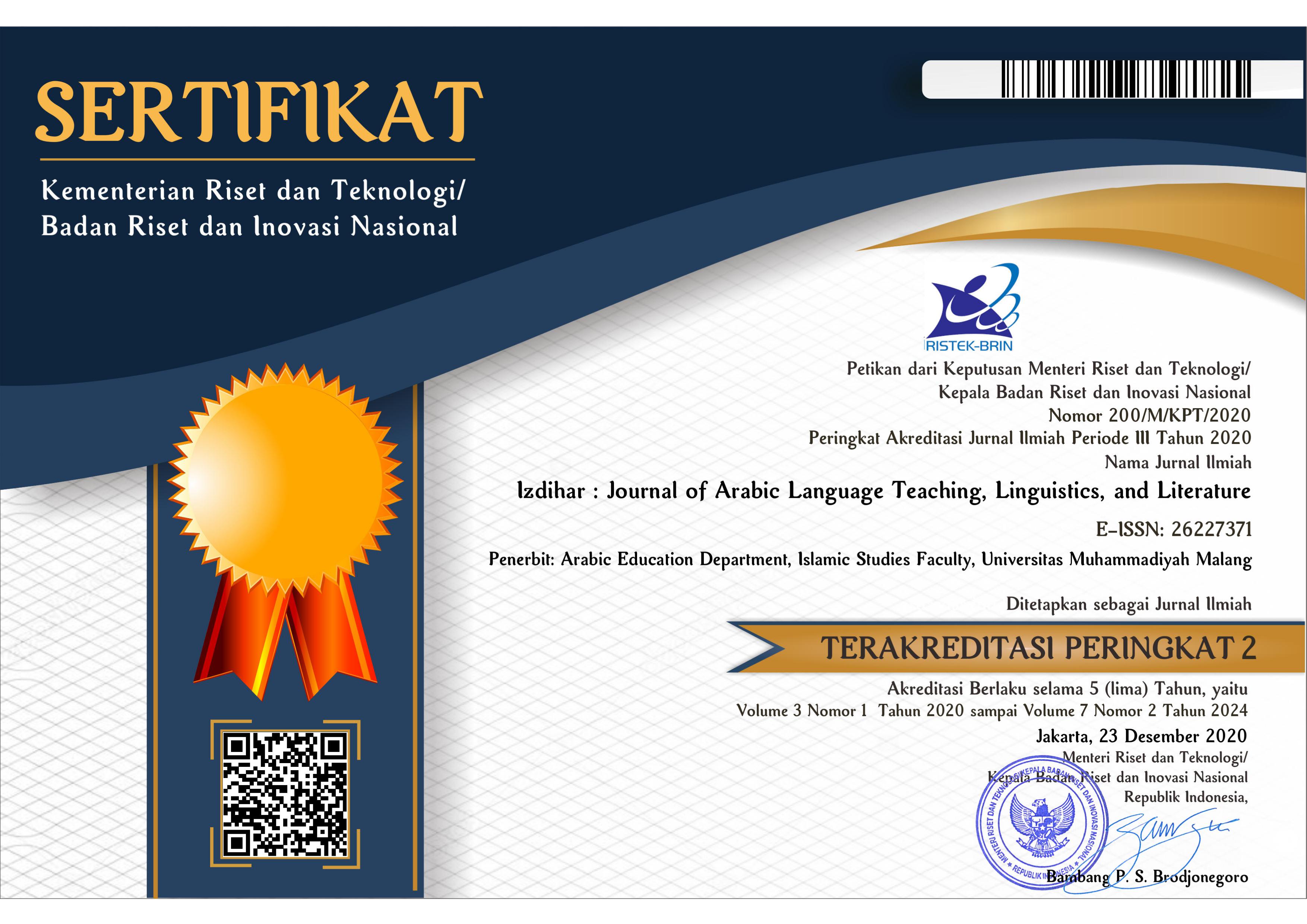Revealing Transitive Verbs in Arabic Short Stories: A Case of Tagmemic Approach
DOI:
https://doi.org/10.22219/jiz.v7i1.25627Keywords:
Active Monotransitive, Arabic short story, Tagmemic, Transitive VerbAbstract
The study aimed to reveal transitive verbs, both active and passive monotransitive, in the Arabic short story “al-’Ajuz was al-’Ushfur” by Mahasin Jadu by using Kenneth L. Pike’s tagmemic theory, which consists of four elements. This study was qualitative-descriptive. Data was collected by reading and noting techniques from short story texts based on Kenneth L. Pike’s four tagmemic elements. The result of the study showed that based on Kenneth L. Pike’s four tagmemic elements, active transitive verbs were expressed by using four structures: (1) transitive verb phrase, noun phrase 1, and noun phrase 2; (2) transitive verb phrase, noun phrase 1, noun phrase 2, and adjunct (prepositional phrase); (3) transitive verb phrase, noun phrase 1, and noun phrase 2; (4) transitive verb phrases (noun phrase 1), adjunct (prepositional phrase), and noun phrase 2. The passive monotransitive verbs founded on one structure were expressed by using transitive verb phrases, noun phrases 1, and noun phrases 2. The result of this study shows that in many cases of transitive phrases, both active and passive monotransitive forms might stimulate the notion of different meanings by using their own syntactic structures.
Downloads
References
Akbarnezhad, S., Sadighi, F., & Bagheri, M. S. (2020). A Syntactic-Based Approach to the Perception and Production of English Verbs’ Argument Structures by Iranian EFL Learners. Cogent Arts & Humanities, 7(1), 1–23. https://doi.org/https://doi.org/10.1080/23311983.2020.1770956
Alatis, J. E. (1992). Georgetown University Round Table on Languages and Linguistics (GURT) 1991: Linguistics and Language Pedagogy. Georgetown University Press.
Arai, M., & Keller, F. (2013). The Use of Verb-Specific Information for Prediction in Sentence Processing. Language and Cognitive Processes, 28(4), 525–560. https://doi.org/https://doi.org/10.1080/01690965.2012.658072
Arfianti, I. (2020). Pragmatik: Teori dan Analisis (Buku Ajar). CV. Pilar Nusantara.
Armann-Keown, V., & Patterson, L. (2020). Content Analysis in Library and Information Research: An Analysis of Trends. Library and Information Science Research, 42(4), 1–12. https://doi.org/https://doi.org/10.1016/j.lisr.2020.101048
Arunachalam, S., & Dennis, S. (2018). Semantic Detail in The Developing Verb Lexicon: An Extension of Naigles and Kako (1993). Development Science, 22(1). https://doi.org/https://doi.org/10.1111/desc.12697
Basid, A., Fatim, A. L. N., As’sa’idah, A. A., & Muid, I. (2023). Construction of The Equative Independent Clause in The Anecdot of “Juha wa Al-Hishan Al-Gharib” by Ahmed Naguib Based on Kenneth L. Pike's Perspective. Lughawiyah: Journal of Arabic Education and Linguistics, 5(2), 99–121. https://doi.org/http://dx.doi.org/10.31958/lughawiyah.v5i2.9512
Basid, A., Syafina, H. I., Hayati, H., Nazir, H., & Razi, F. (2022). Binā al-Jumal al-Mu’aqqodah fī Riwayah “Mā Lā Nabūh Bih” ala Asāsi Nadhariyyati Tagmemic Kenneth L. Pike (Complex Sentence Construction in Novel “Mā Lā Nabūh Bih” Based on the Perspective of Kenneth L. Pike’s Tagmemic). Okara: Jurnal Bahasa Dan Sastra, 16(2), 214–244. https://doi.org/https://doi.org/10.19105/ojbs.v16i2.6024
Basid, A., Syahril, M., Muzakky, M. I., Muttaqin, I., & Imaduddin, M. F. (2022). Intransitive Independent Clauses in Film “Ḏīb”: Modern Linguistic Study Based on Kenneth L. Pike’s Tagmemic Perspective. Arabiyatuna: Jurnal Bahasa Arab, 6(2), 349–373. https://doi.org/http://dx.doi.org/10.29240/jba.v6i2.4240
Berends, H., & Deken, F. (2021). Composing Qualitative Process Research. Strategic Organization, 19(1), 1–13. https://doi.org/https://doi.org/10.1177/1476127018824838
Burton-Roberts, N. (2016). Analysing Sentences: An Introduction to English Syntax. Taylor & Francis.
Calderon, S. S. (2021). Simple Monotransitive and Complex Dative Alternation Predicates in Spanish Monolingual Child Acquisition Data. Probus, 33(1), 1–29. https://doi.org/https://doi.org/10.1515/prbs-2021-0005
Camilleri, M. (2019). The Development of the Universal Perfect in Arabic. Language: Linguistic Society of America, 95(4), 683–710. https://doi.org/10.1353/lan.2019.0070
Cook, W. A. (1989). Case Grammar Theory. Georgetown University Press.
Donnelly, S., & Kidd, E. (2021). On the Structure and Source of Individual Differences in Toddlers’ Comprehension of Transitive Sentences. Frontiers in Psychology, 12, 1–17. https://doi.org/https://doi.org/10.3389/fpsyg.2021.661022
Edwards, B. L. (2006). Tagmemics. In Encyclopedia of Language & Linguistics (Second Edi, pp. 477–480). https://doi.org/https://doi.org/10.1016/B0-08-044854-2/02052-6
Febriani, I. (2018). Tagmemics Analysis of Using Language Linguistic Data of Banyuwangi. 2nd Social Sciences, Humanities and Education Conference: Establishing Identities through Language, Culture, and Education (SOSHEC 2018). https://doi.org/10.2991/soshec-18.2018.88
Ferguson, C. A. (2019). Theoretical Foundations. De Gruyter.
Gelderen, E. van. (2010). An Introduction to the Grammar of English. John Benjamins Publishing Company.
Grani, T., & Kennedy, C. (2012). Mandarin Transitive comporativesComparatives and The Grammar of Measurement. Journal of East Asian Linguistics, 21, 219–266. https://doi.org/https://doi.org/10.1007/s10831-012-9090-y
Hallman, P. (2022). Head and Dependent Marking in Clausal Possession. Linguistic Inquiry, 53(3), 551–570. https://doi.org/https://doi.org/10.1162/ling_a_00416
Holton, D., Mackridge, P., Philippaki-Warburton, I., & Spyropoulos, V. (2012). Greek: A Comprehensive Grammar of the Modern Language. Taylor & Francis.
Hwang, H. (2022). Syntactico-Semantic Realizations of Pronouns in the English Transitive Construction: A Corpus-Based Analysis. Corpus Linguistics and Linguistic Theory, 18(1), 115–143. https://doi.org/https://doi.org/10.1515/cllt-2019-0061
Ito, H. (2021). From Native-Speaker Likeness of Self-Representation in Language: Views from the Acquisition of Japanese Transitive and Intransitive Verbs. Acta Linguistica Asiatica, 11(1), 25–36. https://doi.org/https://doi.org/10.4312/ala.11.1.25-36
Jadu, M. (2008). Al-’Ajuz wa Al-’Ushfur. Bidayah.
Jaeni, M. (2018). A Comparative Study of Ngapsahi Analysis and Tagmemic Analysis on Arabic Texts in Kitab Kuning. Alsinatuna: Journal of Arabic Linguistics and Education, 4(1), 19–32. https://doi.org/https://doi.org/10.28918/alsinatuna.v4i1.1590
Kayama, Y., & Oshima-Takane, Y. (2022). The Acquisition of Argument Structures of Intransitive and Transitive Verbs in Japanese : The Role of Parental Input. First Language, 42(1), 144–167. https://doi.org/10.1177/01427237211059970
Keraf, G. (1984). Tatabahasa Indonesia. Nusa Indah.
Kinney, J. (1978). Tagmemic Rhetoric: A Reconsideration. College Composition and Communication, 29(1), 141–145. https://doi.org/https://doi.org/10.2307/357298
Mcintyre, J. (2020). Transtive L-Verbs (grade 2) and Transitive H-Verb (grade 1,4,5, and 6) in Hausa Verbal Compounds. Studies in African Languages and Cultures, 54. https://doi.org/https://doi.org/10.32690/SALC54.1
Miles, M. B., Huberman, A. M., & Saladana, J. (2014). Qualitative Data Analysis A Methods Sourcebook Edition 3. Sage.
Moller, V. (2017). Language Acquisition in CLIL and Non-CLIL Settings: Learner Corpus and Experimental Evidence on Passive Constructions. John Benjamins Publishing Company.
Moltmann, F. (2020). Truthmaker Semantics for Natural Language: Attitude Verbs, Modals, and Intensional Transitive Verbs. Theoretical Linguistics, 46(3–4), 159–200. https://doi.org/https://doi.org/10.1515/tl-2020-0010
Muhartoyo. (2012). The Functional Slots of Finite Verb Tagmas. Binus Journal Publishing, 3(1), 70–80. https://doi.org/https://doi.org/10.21512/humaniora.v3i1.3235
Ozturk, B. (2021). Transitive Unergatives in Pazar Laz. Glossa: A Journal of General Linguistics, 6(1), 1–24. https://doi.org/https://doi.org/10.5334/ gjgl.828
Pahor, N. (2021). Corpus Analysis of the Collocations of the Transitive Verb Owaru and Oeru. Acta Linguistica Asiatica, 11(1). https://doi.org/https://doi.org/10.4312/ala.11.1.37-74
Pike, K. L. (1992). Konsep Linguistik: Pengantar Teori Tagmemik. Summer Institute of Linguistics.
Pike, K. L., & Pike, E. G. (1982). Grammatical Analysis. The Summer Institute of Linguistics and The University of Texas at Arlington.
Porter, S. E., & Dawson, Z. K. (2021). Pillars in the History of Biblical Interpretation: Further Essays on Prevailing Methods. Pickwick Publications.
Poythress, V. (2022). A Semiotic Analysis of Multiple Systems of Logic: Using Tagmemic Theory to Assess the Usefulness and Limitations of Formal Logics, and to Produce a Mathematical Lattice Model Including Multiple Systems of Logic. Semiotica. https://doi.org/https://doi.org/10.1515/sem-2020-0051
Poythress, V. S. (2021). Semiotic Analysis of Symbolic Logic using Tagmemic Theory: with Implications for Analytic Philosophy. Semiotica. https://doi.org/https://doi.org/10.1515/sem-2020-0018
Schirakowski, B. (2021). What Constrains the Formation of Spanish Nominalized Infinitives?: A Case Study on Transitive Verb and Event Interpretations. In Formal Approaches to Romance Morphosyntax (pp. 245–246). De Gruyter. https://doi.org/https://doi.org/10.1515/9783110719154-008
Sebeok, T. A., Posner, R., & Rey, A. (1986). Tactile Communication. In Encyclopedic Dictionary of Semiotics (p. 1072). De Gruyter Mouton.
Stanlaw, J. (2021). Pike, Kenneth. In The International Encyclopedia of Linguistics Anthropology (pp. 2000–2001). John Wiley & Sons. https://doi.org/10.1002/9781118786093.iela0315
Tamm, A. (2003). Estonian Transitive Verb Classes, Object Case, and Progressive. 19th Scandinavian Conference of Linguistics, 639–653. https://doi.org/https://doi.org/10.7557/12.30
Tarigan, H. G. (1986). Prinsip-Prinsip Dasar Sintaksis (Cet. ke-4). Angkasa.
Theakston, A. L., Maslen, R., Lieven, E. V. M., & Tomasello, M. (2012). The Acquisition of The Active Transitive Construction in English: A Detailed Case Study. Journal Cognitive Linguistics, 23(1). https://doi.org/https://doi.org/10.1515/cog-2012-0004
Verspoor, M. H., Kassenberg, T., Keijzer, M., & Poarch, G. J. (2022). English Sentence Constructions. John Benjamins Publishing Company.
Wijaya, D. (2022). Grammatical Markers of Enggano Transitive Verb in Perfective and Imperfective Aspect. 3rd International Conference on Educational Science and Teacher Profession (ICETeP 2021). https://doi.org/10.2991/978-2-494069-19-0_18
Xiong, J., & Huang, C.-R. (2014). On The Argument Structures of the Transitive Verb Fan “Annoy; be Annoyed; Bother to do”: A Study Based on Two Comparable Corpora. 28th Pacific Asia Conference on Language, Information and Computation, 615–623. https://aclanthology.org/Y14-1070.pdf
Yuan, S., Fisher, C., & Snedeker, J. (2012). Counting The Nouns: Simple Structural Cues to Verb Meaning. Society of Research in Child Development, 83(4), 1382–1399. https://doi.org/https://doi.org/10.1111/j.1467-8624.2012.01783.x
Zongjie, W., & Jinghui, W. (2016). Analysis of Japanese Intransitive Verb and Transitive Verb Expressions Based on Different Perspectives. 7th International Conference on Education, Management, Information and Computer Science (ICEMC 2017). https://doi.org/10.2991/icemc-17.2017.126
Downloads
Published
How to Cite
Issue
Section
License
Copyright (c) 2024 abdul - basid, Al Lastu Nurul Fatim, Jumriyah Jumriyah, Masrokhin Masrokhin

This work is licensed under a Creative Commons Attribution-ShareAlike 4.0 International License.
Copyright Notice
Authors who publish with this journal agree to the following terms:
- Authors retain copyright and grant the journal right of first publication with the work simultaneously licensed under a Creative Commons Attribution-ShareAlike 4.0 International License that allows others to share the work with an acknowledgment of the work's authorship and initial publication in this journal.
- Authors are able to enter into separate, additional contractual arrangements for the non-exclusive distribution of the journal's published version of the work (e.g., post it to an institutional repository or publish it in a book), with an acknowledgment of its initial publication in this journal.
- Authors are permitted and encouraged to post their work online (e.g., in institutional repositories or on their website) prior to and during the submission process, as it can lead to productive exchanges, as well as earlier and greater citation of published work (See The Effect of Open Access).
Copyright (c) 2019 Izdihar : Journal of Arabic Language Teaching, Linguistics, and Literature

This work is licensed under a Creative Commons Attribution-ShareAlike 4.0 International License.


















